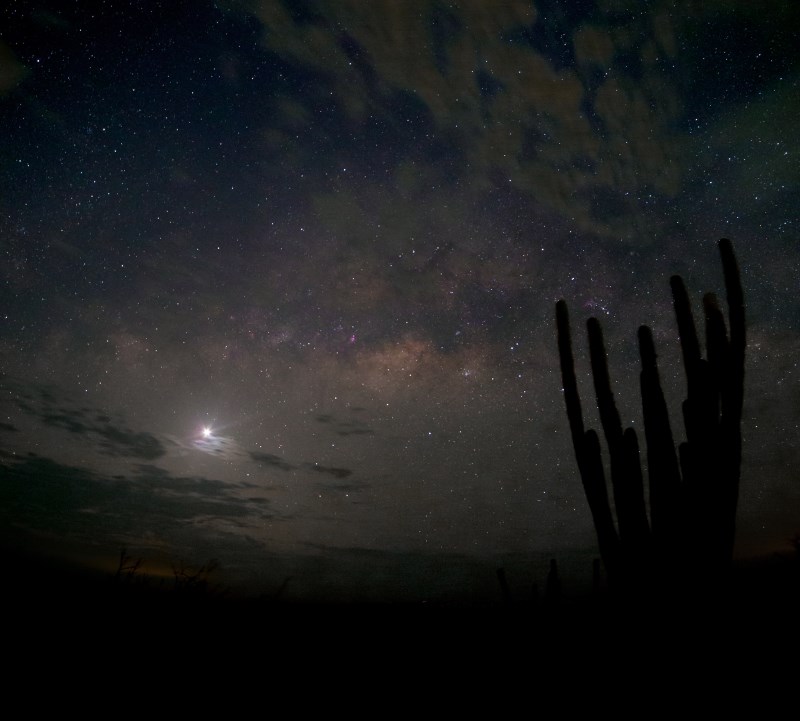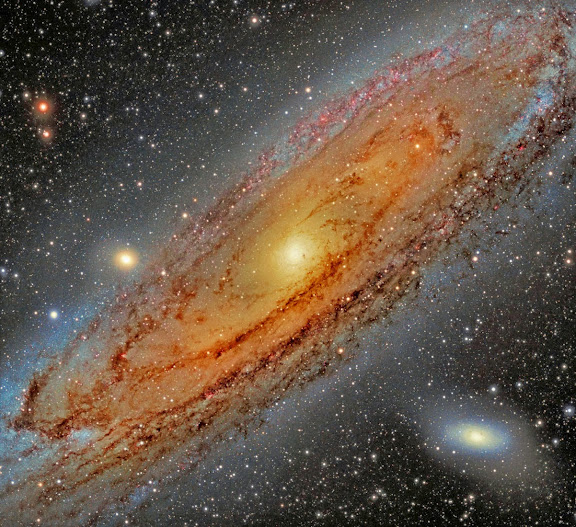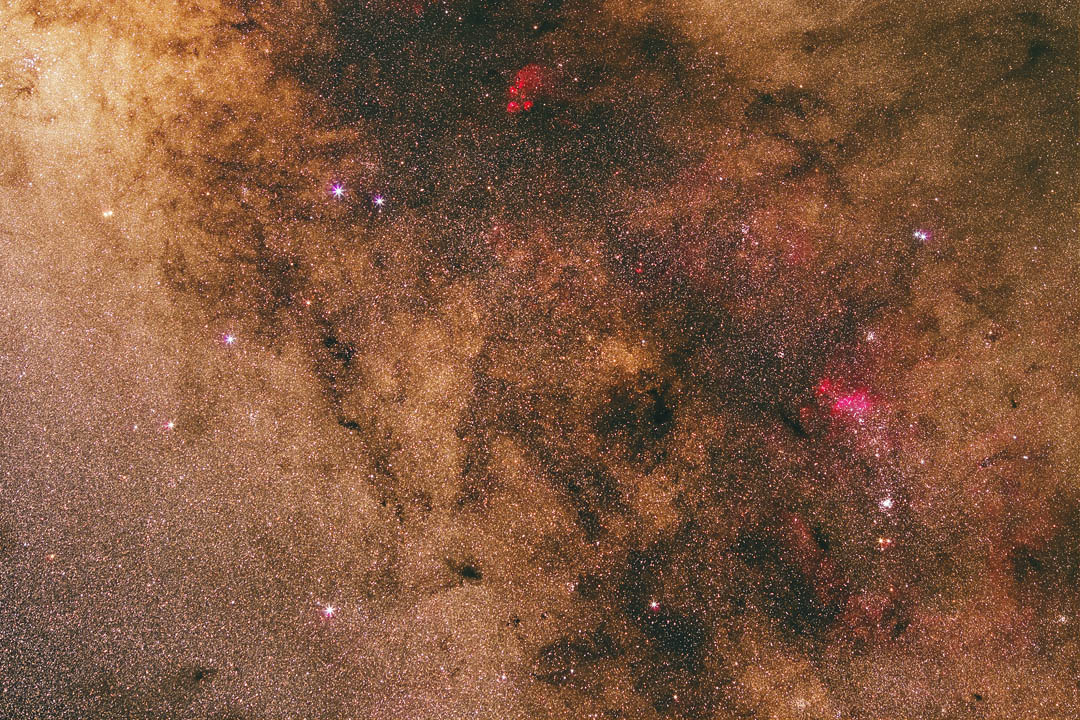Page 7 of 10
The Dumbbell Nebula 250 years later
Posted: Sat Feb 15, 2014 5:09 pm
by antonioccd
The first planetary
Copyright: Antonio Peña, Spain

This was the first planetary nebula discovered by Charles Messier in 1764. 250 year later, in 2014, I have taken this image from Madrid, Spain.
After the first image processing and after posting the image on some local forums in Spain, the general comment was focused on increasing the contrast on the nebula. This is the second processing batch with higher contrast.
Best regards,
Antonio
Venus at dawn in Aruba
Posted: Sat Feb 15, 2014 7:41 pm
by lynnhilborn
Higher res at
http://www.nightoverontario.com/Astrono ... &lb=1&s=X2
Canon 6d modified 3200ISO, 22 seconds, 14mm lens @f2.8
Thanks for looking
Cheers
Lynn
Re: Submissions: 2014 February
Posted: Sat Feb 15, 2014 9:08 pm
by IO_12
Sh2-261
Copyright: Velimir Popov, Emil Ivanov @
Irida Observatory
More info and hi-res images on
website
Re: Submissions: 2014 February
Posted: Sun Feb 16, 2014 12:21 am
by gvanhau
Re: Submissions: 2014 February
Posted: Sun Feb 16, 2014 9:19 am
by astroligu
Rolando Ligustri wrote: the Great M31, Andromeda galaxy, here a picture which is the composition of several photos of multiple authors, made with different instruments. in alphabetical order: Domenico Argentiero, Claudio Bottari, Giuseppe Donatiello, Marco Favuzzi, Terenzio Fusco, Rolando Ligustri, Andrea Pistocchini, Stefano Schirinzi.
link for high res,
http://www.astrobin.com/78540/
IC443-IC444-Sh2-249
Posted: Sun Feb 16, 2014 8:55 pm
by astrogades
Re: Submissions: 2014 February
Posted: Sun Feb 16, 2014 9:42 pm
by Astromontufar
Violet
Meteor Over Guatemala City.
20140215
http://www.astrobin.com/78657/
by Sergio Montúfar
Jupiter on February 15th, 01:28ut.
Posted: Mon Feb 17, 2014 3:34 pm
by Efrain Morales
Jupiter on February 15th, 01:28ut. The GRS is approching the limb, a bright disturbance at the mid position at the contrails trailing end. (Equipment: LX200ACF 12 in. OTA, CGE mount, Flea3 Ccd, TeleVue 3x barlows, Astronomik RGB filters. 1 min. per channel.)
Mars on February 15th, 09:28ut.
Posted: Mon Feb 17, 2014 3:38 pm
by Efrain Morales
Mars on February 15th, 09:28ut. High altitude clouds on the Xanthe region (mid.left) also on Hellas region (lower right) and at Syrtis Major regions (equat.).
Saturn on February 12th, 09:30ut.
Posted: Mon Feb 17, 2014 3:41 pm
by Efrain Morales
Saturn on February 12th, 09:30ut. (LX200ACF 12 in.OTA, CGE mount, Flea3 ccd, TeleVue 3x Barlows, Astronomik LRGB filter set.)
Re: Submissions: 2014 February
Posted: Mon Feb 17, 2014 6:24 pm
by Oleg Bryzgalov
Horsehead and NGC2023 in Orion
2013, November
HiRes photo:
http://olegbr.astroclub.kiev.ua/files/a ... zgalov.jpg
Copyright: Oleg Bryzgalov, Ukraine
Re: Submissions: 2014 February
Posted: Mon Feb 17, 2014 8:32 pm
by sternklar
Star Field Tail of Scorpius with Cat's Paw Nebula (NGC 6334) and Prawn Nebula (IC 4628), Namibia, July 2013
http://www.sternklar.ch/images-webpages ... Jul-13.htm
Copyright: Manuel Jung
Re: Submissions: 2014 February
Posted: Tue Feb 18, 2014 3:33 am
by marion165
Moonlight Across the Snow
http://www.flickr.com/photos/radicalret ... 574698474/
Copyright: Marion Haligowski
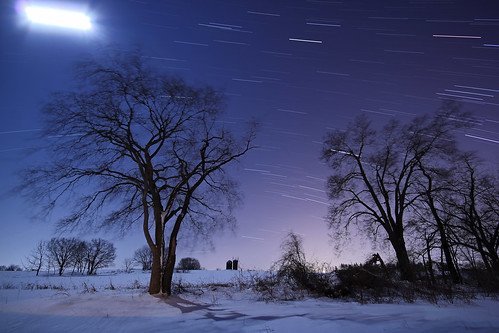 Moonlight Across the Snow
Moonlight Across the Snow by
Radical Retinoscopy, on Flickr
Trailing of the full moon and Orion over a snow covered field can be seen in this star trail photo made of 73 twenty second exposures. (Canon T2i and a Sigma 10-20 mm lens @ 10 mm / ISO 400 / f/6.3)
Re: Submissions: 2014 February
Posted: Tue Feb 18, 2014 9:56 am
by STAVROS HIOS
Re: Submissions: 2014 February
Posted: Tue Feb 18, 2014 11:35 am
by Oko1
CentaurusA, NGC5128
Click the thumbnail to display 100% resolution with acquisition and processing details.
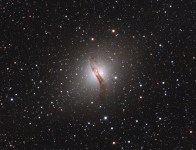
Attempt to process gently with accent to the details in dust lane, and hopefully natural look/shape of the stars.
Re: Submissions: 2014 February
Posted: Tue Feb 18, 2014 12:16 pm
by SkyViking
NGC 3576/3603 - The Statue of Liberty Nebula
http://www.rolfolsenastrophotography.com
Copyright: Rolf Wahl Olsen
Link to full resolution image (4.1 MB)
This rich and complex scene shows the glowing clouds of NGC 3576 and NGC3603 in the Southern constellation of Carina.
The large pink nebula on the right is NGC 3576, an impressive looking but relatively close and small nebula in the Sagittarius Arm of our Milky Way galaxy, some 9,000 light years away. On the left is the much more distant and larger NGC 3603, located a further 14,000 light years behind NGC 3576.
NGC 3576 is also known as the Statue of Liberty Nebula because of the striking shape visible in the core. The delicate loops are approximately 100 light years wide and are caused by material being blown outwards by the intense radiation pressure from young stars in the centre of the nebula. Most of these stars are hidden from our view in the bright area at the base of the loops.
The more distant NGC 3603 on the left is noticeably reddened due to obscuring interstellar dust and appears almost deep red in comparison with the un-obscured pink NGC 3576 on the right. NGC3603 is the largest nebula in our galaxy and is classified as a giant HII region. It would appear as a noticeable large reddish glow to observers in other galaxies.
A very bright massive central star cluster can be seen lighting up this nebula, and although these stars are in reality all young and blue they appear yellow to us because of the intervening dust. This effect can be seen in a number of other nebulae, such as the star cluster Pismis 24 in the
Lobster Nebula (NGC 6357).
The cluster contains some of our galaxy's most massive stars. One of these, a mammoth of 60 solar masses named Sher25, appear to have expelled circumstellar shells of material very similar to the rings seen around Supernova 1987A. These were expelled by the progenitor star some time prior to the supernova explosion, which might indicate that Sher25 is a candidate for the next supernova explosion in our galaxy.
The entire area is seen though the incredibly dense star fields of Carina, with numerous condensations and beautiful groupings in and around the nebulae. This iconic Southern constellation which is best known for the enormous Carina Nebula is a real treasure trove of deep sky objects.
Image details:
Date: 1
st, 3
rd, 7
th, 24
th, 27
th, 28
th and 30
th January 2014
Exposure: LRGB: 805:105:95:75 mins, total 18 hours @ -25C
Telescope: 12.5" f/4 Serrurier Truss Newtonian
Camera: QSI 683wsg with Lodestar guider
Filters: Astrodon LRGB E-Series Gen 2
Taken from my observatory in Auckland, New Zealand
Re: Submissions: 2014 February
Posted: Tue Feb 18, 2014 12:59 pm
by Hung-Hsuan Yen
The light of Venus
https://fbcdn-sphotos-e-a.akamaihd.net/ ... 3811_o.jpg
[attachment=0]1015919_611999515538611_102823811_o.jpg[/attachment]
Time: 2014/2/7
Location: Kenting National Park, Taiwan
Optics: Canon EF 24mm f/1.4L II USM -> f/2.8
Camera: modified Canon 5D2
Exposure: 13s at ISO6400
星天日和
https://www.facebook.com/redscosky
Northern Cepheus widefield
Posted: Tue Feb 18, 2014 5:54 pm
by Kapkowski
Nothern part of Cepheus. Fascinating dark nebulas - widefield. Vdb 149& 150 to VdB 152 with delicate sign of DeHT 5.
Mosaic taken with Officina Stellare Veloce RH 200 and STL 11000.
Full resolution :
http://imageshack.com/a/img812/3961/gs0y.jpg
Enjoy!
West form beta Cephei
Posted: Tue Feb 18, 2014 6:08 pm
by Kapkowski
"Cepheus story" continued

WIdefield mosaic from VdB 141 Ghost Nebula through NGC 7023 Iris Nebula to LBN 468.
Taken with Officina Stellare Veloce RH 200 and SBIG STL 11000.
Full resolution :
http://imageshack.com/a/img34/2509/d8s8.jpg
Re: Submissions: 2014 February
Posted: Tue Feb 18, 2014 8:44 pm
by drlane
Echos of Gould's Belt
A deep exposure of M45 reveals a look at a series of Gould Belt filaments. Gould's Belt was first written about in 1879 by astronomer Benjamin Gould. Gould's Belt consists of interstellar dust, gas and bright stars and is a bit of a mystery. Perhaps it's a leftover remnant of a small galaxy, swallowed by the Milky Way or a dust cloud remnant of a expired cluster. Or as many think possible, a series of supernovas. What is known is it appears to have occurred about 50 million years ago and the belt is inclined at a 20 degree angle to the plane of the Milky Way. M45, also known as the Pleiades, just happens to be passing through Gould's Belt and isn't a part of it. M45's proximity to earth and brightness gives us a fantastic look at the interior dust lanes of this mysterious belt.
This image is the equivalent of 135 hours of RGB exposure with many exposures of 20 minutes. The dust tendrils of Gould's Belt are illuminated by the extra long exposures and combined length of exposure

Link to a bit larger version. Full resolution available.
http://re-prop.com/M45_Final_sm.jpg
Re: Submissions: 2014 February
Posted: Tue Feb 18, 2014 10:45 pm
by avdhoeven
Image of M81/82. Combination of data taken by several setups to bring out the most detail. This image was made from the light-polluted area near the City of Rotterdam in The Netherlands.
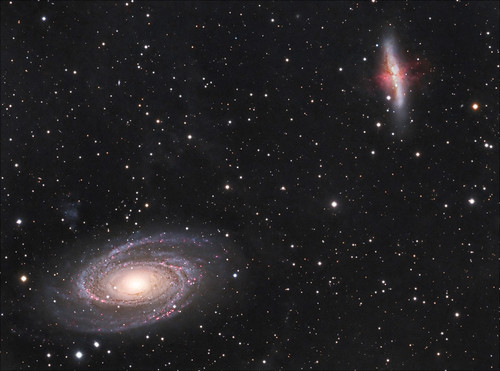 M81/82 with SN2014J
M81/82 with SN2014J by
Andre vd Hoeven, on Flickr
Re: Submissions: 2014 February
Posted: Wed Feb 19, 2014 9:34 am
by Michael Deger
Hickson 44
http://www.galaxyphoto.de
Copyright Michael Deger
Image details and higher resolution of this image:
http://www.galaxyphoto.de/hickson44vc_I.htm
Best regards, Michael
Re: Submissions: 2014 February
Posted: Wed Feb 19, 2014 6:17 pm
by starsurfer
SkyViking wrote:NGC 3576/3603 - The Statue of Liberty Nebula
http://www.rolfolsenastrophotography.com
Copyright: Rolf Wahl Olsen
Link to full resolution image (4.1 MB)
This rich and complex scene shows the glowing clouds of NGC 3576 and NGC3603 in the Southern constellation of Carina.
The large pink nebula on the right is NGC 3576, an impressive looking but relatively close and small nebula in the Sagittarius Arm of our Milky Way galaxy, some 9,000 light years away. On the left is the much more distant and larger NGC 3603, located a further 14,000 light years behind NGC 3576.
NGC 3576 is also known as the Statue of Liberty Nebula because of the striking shape visible in the core. The delicate loops are approximately 100 light years wide and are caused by material being blown outwards by the intense radiation pressure from young stars in the centre of the nebula. Most of these stars are hidden from our view in the bright area at the base of the loops.
The more distant NGC 3603 on the left is noticeably reddened due to obscuring interstellar dust and appears almost deep red in comparison with the un-obscured pink NGC 3576 on the right. NGC3603 is the largest nebula in our galaxy and is classified as a giant HII region. It would appear as a noticeable large reddish glow to observers in other galaxies.
A very bright massive central star cluster can be seen lighting up this nebula, and although these stars are in reality all young and blue they appear yellow to us because of the intervening dust. This effect can be seen in a number of other nebulae, such as the star cluster Pismis 24 in the
Lobster Nebula (NGC 6357).
The cluster contains some of our galaxy's most massive stars. One of these, a mammoth of 60 solar masses named Sher25, appear to have expelled circumstellar shells of material very similar to the rings seen around Supernova 1987A. These were expelled by the progenitor star some time prior to the supernova explosion, which might indicate that Sher25 is a candidate for the next supernova explosion in our galaxy.
The entire area is seen though the incredibly dense star fields of Carina, with numerous condensations and beautiful groupings in and around the nebulae. This iconic Southern constellation which is best known for the enormous Carina Nebula is a real treasure trove of deep sky objects.
Image details:
Date: 1
st, 3
rd, 7
th, 24
th, 27
th, 28
th and 30
th January 2014
Exposure: LRGB: 805:105:95:75 mins, total 18 hours @ -25C
Telescope: 12.5" f/4 Serrurier Truss Newtonian
Camera: QSI 683wsg with Lodestar guider
Filters: Astrodon LRGB E-Series Gen 2
Taken from my observatory in Auckland, New Zealand
Another great image from you as well as a detailed writeup! I don't know how the so-called "popular" name has caught on, to me it sounds really silly and doesn't resemble its name at all. To me it is still NGC 3576, the "new" name I think comes from Jack Harvey of the Star Shadows team.
Re: Submissions: 2014 February
Posted: Wed Feb 19, 2014 10:11 pm
by Sandgirl
Two comets pass each other (Feb 8th, 2014.)
Copyrights: Damian Peach
Full size:
http://www.damianpeach.com/deepsky/c201 ... 2_08dp.jpg
Comet Lovejoy (Feb 12th, 2014.)
Copyrights: Damian Peach
Photo of anvil cloud over Oklahoma
Copyrights: William Lovallo
Moon and lake Alqueva
Copyrights: Vitor Quinta
Venus and Southern Cross rising over Sea of Cortez
Copyrights: Wally Pacholka
Trails of Canopus & Achernar
Copyrights: Ajay Talwar
Re: Submissions: 2014 February
Posted: Wed Feb 19, 2014 10:37 pm
by Sandgirl
Pulsar's Hand
Image Credit: P. Slane (Harvard-Smithsonian CfA) et al., CXC, NASA; Image Processing: Rogelio Bernal Andreo
IC434&FlameNebula
Copyrights: Martin Pugh
IC 1805 and NGC 896
Copyrights: César Blanco González
Rising Venus from Budapest/Hungary
Copyrights: Simics Ferenc
Insinuated moon
Copyrights: J.J. Losada
Deep Tarantula in Narrowband Hubble Palette
Copyrights: Ian Sharp
Full size:
http://www.astro-sharp.com/images/DeepS ... S_50PC.jpg
Bunch of winter stars
Copyrights: Tunc Tezel
NGC 6992 - The Eastern Veil Nebula
Copyrights: Oliver Czernetz


